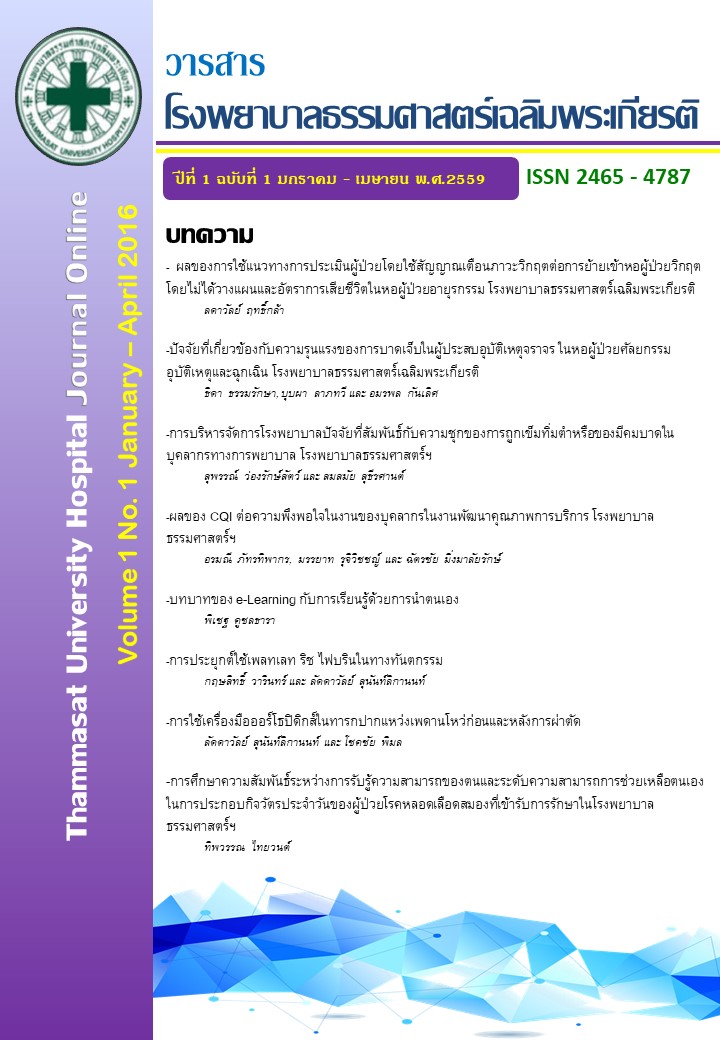The Results of Using the Evaluation form for Early Warning Signs on Unplanned ICU Admission and Mortality Rate in Internal Medicine Ward at Thammasat University Hospital
Keywords:
Modified early warning scores system, Unplanned ICU, Mortality rateAbstract
The quality of patient care and patient safety is considered the most important practice in medical care. The evaluation of clinical status is crucial to prevent the degradation and mortality. The study is aimed to determine effects of the evaluation of early warning signs on unplanned ICU admission and mortality rate.
A quasi-experimental research, comparing two groups study was performed in a medical ward at Thammasat University Hospital between January to June 2014. A total of 180 patients were enrolled in the study for a period of 12 weeks (90 people per group). The experimental group were assessed by Modified early warning scores system (MEWS). The data were analyzed using descriptive statistics.
After12 weeks of the study (post-study period), the incidence rate of unplanned ICU and mortality rates were lower in the experimental group (p< 0.01 and < 0.05 consequently). Encouragement of using of Modified early warning scores system (MEWS) for patients care can improve patient care. Implementation of this tool can decrease unplanned ICU and mortality rate. Further studies are needed with larger population and longer period of study to verify the effectiveness of this practice.
References
งานเวชระเบียนและสถิติ: สถิติ โรงพยาบาลธรรมศาสตร์เฉลิมพระเกียรติ, 2557
สำนักสถิติพยากรณ์ สำนักงานสถิติแห่งชาติ. (2557). From https://service.nso.go.th/nso/web/statseries/statseries09.html
Ann Tourangeau. (2002). ICES Reports: Nursing Skill Mix and Experience Reduce Patient Mortality. Healthcare Quarterly, 5(3), 19-20
Burch, V.C., Tarr, G., Morroni, C., (2008). Modified early warning score predicts the need for hospital admission and in hospital mortality. Emergency Medicine Journal, 25(10): 674.
Emma Baines & N S Kanagasundaram. (2008). Early Warning Scores. British Medical Journal, 16(7), 294-336.
Gardner -Thorpe J., et al. (2006). The Value of Modified Early Warning score (MEWS) in surgical In-patients: A prospective observational study. Ann R Coll Surg Engl, 88, 571–575.
Jennifer McGaughey, et al. (2007). Outreach and EarlyWarning Systems (EWS) for the prevention of Intensive Care admission and death of critically ill adult patients on general hospital wards. The Cochrane Collaboration and published, 3.
M. Institute for Healthcare Improvement. (2011). Early warning systems: score cards that save lives. From https://www.ihi.org/resources/Pages/ImprovementStories/EarlyWarningSystemsScorecardsThatSaveLives.aspx
Mehtap Bulut, et al. (2013). The comparison of modified early warning score with rapid emergency medicine score: a prospective multicentre observational cohort study on medical and surgical patients presenting to emergency department. Emergency Medicine Journal.
Semico Miller. (2009).The Use of Modified Early Warning Scores by a Rapid Response Team For The Purpose of Code Reduction in the Non-ICU Patient Population. ANCC National Magnet Conference.
World Health Organization. (2014). From https://www.who.int/topics/cardiovascular_diseases/en/



